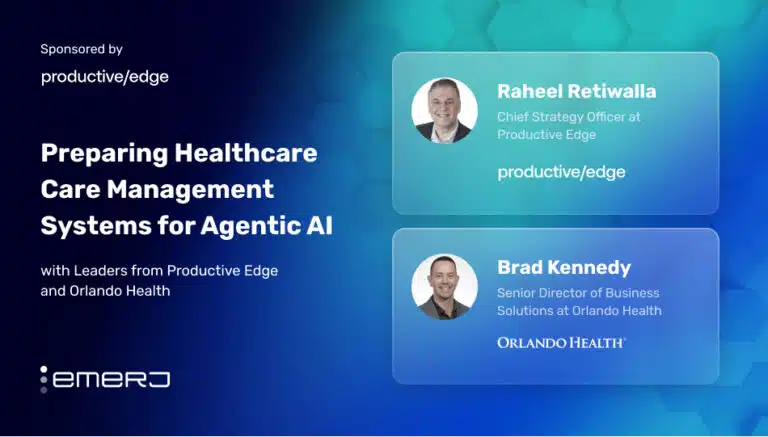This article was originally written as part of an in-depth AI report sponsored by Iron Mountain, and was written, edited and published in alignment with our transparent Emerj sponsored content guidelines. Learn more about our thought leadership and content creation services on our Thought Leadership Services page.
Effectively using data to gain insights is critical to any large business, and it might seem unsurprising that artificial intelligence is now being applied to data search and information discovery to automate processing in business areas such as legal, contracting, and human resources.
For larger businesses, the sheer volume of legal and HR documents might make handling and managing the data within them severely challenging. AI is being used to help businesses in these industries effectively aggregate, manage, and derive insights from the data they are collecting. In real-world business terms, it seems that AI might help reduce the time it takes to process data and derive insights or enable automations that directly improve efficiency in business operations.
Maximilian Versace, PhD, CEO, and President at Neurala, also seemed to agree that leveraging data to reduce costs and time might be among the best business outcomes from AI implementations:
In our business experience, reducing costs/improving process and quality of a product/service for our customers is the best answer to the question ‘Is AI good for me?’ When AI application results in a lower cost and better product, then the answer is clear to the customer and the industry as a whole.
Corporate legal and HR teams at larger firms may deal with thousands of contracts everyday. This might include data from:
- customer contracts
- supplier contracts
- merger and acquisition contracts
- real estate contracts, deeds
- healthcare claims or contract documents
- sensor data from industrial machinery
- vehicle data for heavy industry fleets
- construction raw material supply orders and invoices
- data about enterprise employees and corporate hiring
Traditional data management software also seem to have limits in terms of how much they can augment the capabilities of a human team. This kind of business scenario is where AI search and discovery software seems to be adding the most value across industry verticals. The value proposition for AI search and discovery tools in this case is the capability to process large volumes of incoming as well as legacy enterprise data with a reasonable level of accuracy while simultaneously reducing the time the process takes.
In this report, we discuss some of the key business functions that AI is helping to automate today in legal, contract management, and human resources divisions at companies.
The crux of where AI can help companies leverage contract data to improve common business functions across industries might revolve around:
- Helping corporate lawyers and HR staff find the most relevant contractual documents in a fast and repeatable manner
- Finding a way to take all the contract documents and search through their contents contextually by just asking a question
- Comparing and leveraging older contracts to identify possible differences with new contracts or recommending clauses that can be used in other similar contracts.
In the following sections, we delve deeper into AI use cases for:
- Legal and Contract Management
- Contract Management for Corporate Legal Teams
- Research and Development Operations
- Asset Management
- Human Resources
- Conversational Interfaces for Internal Customer Service
- Application Screening in Hiring
Legal and Contract Management
In a 2017 report, consulting firm KPMG estimated this figure of revenue leakage due to poor contract management issues, such as missing delivery dates, as between 17% and 40% of a contract’s value.
Contract management is a necessary part of most businesses, and the revenue leakage figures quoted above likely signify an immediate need for large businesses to find better ways to organize, automatically categorize, and store this data in an easily queryable way.
Large corporate legal teams might be able to overcome several challenges using AI. Intelligent software can help find ways to cut down on the time taken to track and monitor all their contracts. For instance:
- Corporate lawyers can gain access to the most recent copies of agreements through a simple search query instead of approaching an employee from the accounts teams.
- Legal teams can find ways to securely share documents with private information, such as customer details, to external law firms
- Teams can use AI software to look at historical contracts that might be relevant to any new projects with the intent of cutting down the time taken to draft new contracts.
Contract Management for Corporate Legal Teams
Corporate lawyers need to read through thousands of legal documents, such as nondisclosure agreements and supply chain contracts, and identify any issues for their employers. Traditionally, it takes lawyers years to gain the experience to identify clauses in these documents that may lead to losses. In addition, such a task is labor intensive and time-consuming.
McKinsey estimates that 22% of a lawyer’s job and 35% of a paralegal’s job can be automated. AI contract management software has been demonstrated in legal contract management applications to perform at a comparable level of accuracy to human lawyers. For instance, in one study, a group of 20 lawyers with over two decades of experience at law firms and corporations were pitted against an AI contract management software to spot issues in 5 different NDAs. The AI software was reportedly developed with inputs from academics, data scientists, and legal and machine learning experts.
The AI software was purportedly trained on datasets of existing NDAs in which contractual issues were labeled. This allowed the software to “understand” what made a certain chain of text a contractual issue when presented with unlabeled NDAs.
The study claims the AI software achieved an average accuracy rate of 94% when compared to the human lawyers at 85%. Additionally, the software managed to review contracts in 26 seconds as opposed to human lawyers, who took 92 seconds.
AI-based contract management tools can be tailored to legal use cases, giving them added context to analyze documents.
Research and Development Operations
Large businesses that have research and development operations across several global sites might stand to benefit by adopting AI-based contract management automation, more so because contracts directly affect the bottom lines of these businesses.
Kristóf Zsolt Szalay, CTO at Turbine, sees search and discovery AI being applied to R&D operations in life sciences:
Search and discovery is a large, undervalued area of Artificial Intelligence. This kind of AI is best at figuring out novel hypotheses or combining existing ones. AI is almost the only viable way to process large amounts of data. Search and discovery AI is uniquely able to generate novel findings, possibly becoming a major contributor to R&D activities of a pharmaceuticals company.
For example, pharmaceutical firms might use AI for new drug discovery. Companies might work with AI vendors to analyze their trove of existing data about drug molecules and their properties, in essence to create a “molecular modeling software” that can digitally recreate those drug molecules.
Machine learning algorithms can then be used to predict the pharmaceutical properties of new molecules, which might be relevant to drug discovery and development. The existing data that pharmaceutical firms collect would be curated, tagged, and made machine-readable.
This enables companies to predict the crystal structures and properties of potential drug molecules. AI software might help to manage and coax out actionable insights from a vast data trail that includes several data types, including paper records, images, and videos.
According to Alex Zhavorokov, PhD, founder and CEO, Insilico Medicine, the last step in an AI implementation involves testing and measuring business results.
In companies that currently use non-AI software products for data management, it may be possible to make a business case around the extra revenue that can be brought in by an AI-powered system by improving business operational efficiency
Large firms might have thousands of R&D contracts and agreements with other businesses. These companies usually stand the risk of having to update a particular clause for a specific group of raw material suppliers, for example. In such cases, businesses traditionally use a human team of contract experts who manually scour through these contracts to identify the way clauses are worded. It is unsurprising that this operation takes large amounts of human time and effort. The biggest impacts for businesses using AI here might be in reducing costs and compliance risks in processing all their R&D data.
Asset Management
Large firms across industries usually have several global worksites with extensive product ranges in each geography. In essence, this boils down to the fact that the ongoing products, services, and supply chain contracts signed by companies in this sector are usually highly-customized. AI is being applied to optimize the management and maintenance of business assets with the aim of cutting down the time taken to find information within information related to these assets.
For instance, a large manufacturing firm might need to generate and organize invoices of several types and with varying levels of detail. Finding and extracting information from these contracts and identifying areas where companies can negotiate better prices for them takes a lot of manual effort and time. AI software solutions and robotic process automation bots have been demonstrated to reduce the time and cost of such operations with a comparable level of accuracy to human analysts.
There is evidence of research publications focusing on developing methods to use AI search and discovery tools for improving business decision making. A few examples of asset management applications using AI data search and discovery might be:
- AI software can be input with historical data extracted from contracts about the installed base of products to generate proactive promotional and marketing campaigns for replacements or upgrades.
- AI software can also be trained on warranty claims contract data and then applied to identifying fraudulent claims. Businesses can identify any wrongful claims and adjust warranty times or budget by using AI software to identify trends from service documents and analyzing defect reports.
AI-based asset management software might help businesses use data from sensors pre-built onto machinery and maintenance logs indicating the age and performance history of the machines to predict the likelihood of its failure.
For instance, oil and gas production plants are inherently based in remote locations. Managing the data collected by sensors on the machinery, exploration and production data, and maintenance logs might be challenging and costly. AI can be used to generate a cloud-based database for all on-site data.
An engineer might then be able to type in a search query for “when was the last time the valves were replaced?” or “what spare parts do I need in the next 3 months?” AI software could then automatically retrieve the relevant information about valve replacement from the contents of maintenance logs or present predictions of machinery performances for the next 3 months.
Human Resources
Conversational Interfaces for Internal Customer Service
Artificial intelligence can potentially be applied to human resources (HR) applications across several industries. For example, AI software today might be capable of supporting decision-making and business administration functions for HR.
Data search and discovery AI applications are being applied to improve employee-HR communication, with some businesses being able to use conversational interfaces to allow their employees to access data about holiday lists or access their dental benefit records.
Businesses across industries that can successfully organize and structure their data in a machine-readable format might go on to be the ones that can first offer basic search and information recovery services for HR-related data, which might be in the form of documents, images, or videos.
HR systems using AI can be interfaced with question-answer datasets and use natural language processing to contextually understand employee queries and return information from a predefined database. These solutions might also be used to share information about other benefits or salary records with enterprise employees across industries.
AI might hold promise in HR-employee communication applications due to the fact that most large organizations already generate and collect troves of internal enterprise HR documents. Allowing employees to access the right information at the right time leading to faster operations might be AI’s value add here.
Application Screening in Hiring
Recruitment divisions at large corporations need to screen and filter thousands of incoming job applications and resumes. Traditional hiring management software has helped speed up this task marginally through rules-based automation, but businesses still might find this task challenging.
AI applicant management software might add a lot of value to HR teams across industries by learning to get better at finding the best-fit applicants over each hiring cycle. AI software can help employers across industries identify potential recruits who might choose to stay longer with the company or may perform the best.
There are examples of AI vendors who already provide AI-based application screening software. Commercial AI-software today can aggregate hiring data, such as the sources of hire for recruiting channels or the number of emails exchanged with candidates. Additionally, the software might also “reason” based-on data to curate a list of preferred candidates from declared requirements and trends observed by the software in hiring data.
AI search and discovery tools might allow employers to go beyond simple keyword searches to identifying the best-suited applicants by asking questions in natural language.
For instance, the HR manager at an insurance firm might benefit from AI search and discovery tools applied to hiring data. The manager might be able to ask questions in natural language stating their requirements and AI software can retrieve a list of screened application fitting the need along with information on which candidates need to be contacted first.
AI data search and discovery tools might allow HR teams in large corporates to query hiring data in a way that gives them insights on hiring the best candidates while cutting down on the ‘candidate search’ time.
Concluding Thoughts on AI in Legal, Contract Management, and Human Resources
Large-scale contract management might be one area where AI software can deliver real-world business value today. If businesses in the heavy industry or life science sectors are faced with a large volume of procurement contracts that have varying renewal dates and renegotiation terms, the human contract analysts could spend hundreds of hours reviewing them. The accuracy of their reviews might also suffer due simply to human error.
AI software could help businesses extract data and categorize contracts based on their content. Businesses could review contracts more rapidly and organize and access specific contract information more easily across their organization to reduce any contractual disputes. This could reduce costs and the time spent reviewing and sorting through contracts.
It might well be true that the highest value-add from contract management AI applications might be to businesses with large volumes of contracts. In the next two to five years, this technology might be relevant for most firms.
Zhavorokov adds, in the short term, businesses might look to gain insights from their data, which might help them sell better:
The near-term business value for businesses comes from market access and the ability to sell their products better. Early stage R&D does not impact a CEO’s performance.
Header Image Credit: Bain Mazza & Debski LLP




















